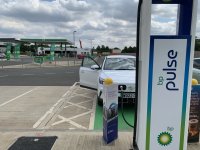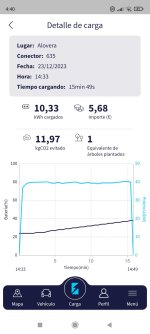So armed with the knowledge above how can I maximise my chances of getting a decent charging rate? 40kw is okay but it's far from ideal.
Honestly, you can't. Other than when you choose to charge battery percentage wise (charging a battery when it is at a lower state of charge will usually allow for a faster rate of charge. As the battery charges, that rate will decline).
Battery temperature makes a difference but you can't really do anything about that on an MG (if you have a Supercharger entered into a Tesla's satnav it will precondition the battery to optimal temperature for when you arrive, so that you'll get the fastest rates - essentially using a bit of battery to subsequently charge it faster). You can't do that on an MG so isn't something you can "do" to improve charging.
You're essentially at the mercy of the various circumstances I set out above but with no way of knowing (you can't see if the charger is being remotely throttled, if there are national grid limitations to the site etc).
The only real thing you can do to improve chances, if this is even possible when you arrive at a charger, is to try and choose a completely free stall (i.e. not a stall that has two cables, with one in use) and if there are multiple stalls, try and choose one as far from the next one in use as possible. That'll be the best chance of having one that isn't sharing incoming power with another stall, although no guarantee.
(For what it's worth, my old Nissan Leaf used the CHAdeMO "rapid charger" standard, which is thankfully now defunct. They charged at a maximum rate of 46kw and on the rare occasion you actually managed to find a CHAdeMO charger at a motorway services, you'd be lucky to pull anything faster than 20kw).
I'm subscribed to a guy on YT who has a Polestar 2 & they have the exact same problems with charging infrastructure & charging speeds. He explains why you don't get the advertised charging speed with some chargers. Worth a watch if you've got half an hour or so to spare.
At the start, he says that the 150kw charging station has been fitted with 200A cables by mistake, as they will only allow a maximum of 80kw to be delivered. I suspect it wasn't a mistake at all. It's more likely to me that it's the same point I made above about the 150kw rate being for the stall itself and the cables essentially act as a physical rather than remote throttle on power being delivered to each vehicle (i.e. 2 x 80 = 160kw and within range of the 150kw rating).
For context, the below screengrabs are my last five Tesla charges using a Supercharger. The car has a maximum DC charge rate of 250kw. I was using 150kw chargers. The highest rate it ever hit was 127kw and that was peak. The highest average speed for any charge was 79kw, so about half of the chargers' rated power delivery. I suspect the others stalls were in use.
None of that bothers me, because a 25 minute charge (long enough to pop in for a coffee and loo break with a two year old), adds 100+ miles of range, which is usually more than I need if I left with a full charge anyway. But that obviously depends on the car you have, your max range when you leave and how long a journey you have etc.

